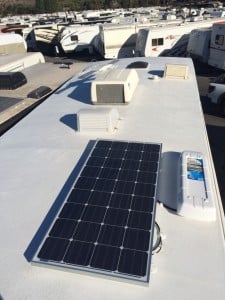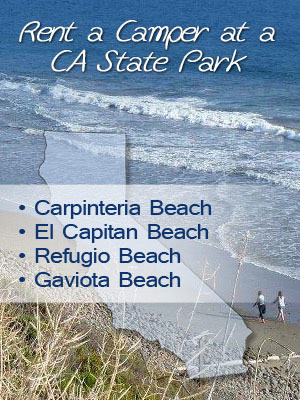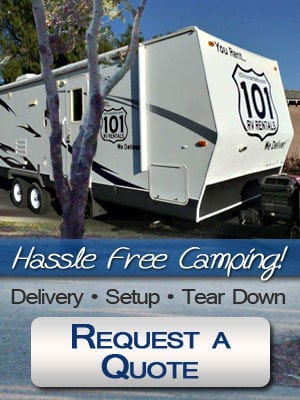With our RV solar panels, 101 RV Rentals offers an efficient way to bring energy to your motorhome. Not only are solar panels affordable for RV owners, but they also require little maintenance and give more independence when traveling in Orange County. For more information, call our office at (805) 210-7391.
RV Solar Solutions Solar Panel FAQ
Clean Energy from RV Solar Panels
As a modern innovation to everyday energy use, RV solar panels harness the power of the sweltering sun in Los Angeles, CA. At 101 RV Rentals, we offer solar kits and complete systems that are a more efficient power source than generators. Here’s a few reasons why you should be investing in solar panels:
Did you know that maintaining RV solar panels is extremely easy? This green alternative to power production doesn’t have intricate moving parts like a generator, so the only regular maintenance work is cleaning the glass of the system.
RV batteries have a lifespan of two to three years. When the battery is drained during a trip, most RV owners recharge the battery with a generator; however, the voltage never returns back to 100%. By switching to RV solar, you’ll have optimal battery levels while under the sun’s rays.
Say goodbye to the loud noises of a generator, and welcome the peace and quiet of an RV solar panel system! Without moving parts and fuel to burn, you’ll no longer experience noise and fumes during a camping trip. Cutting the cord on those clunky generators will feel liberating.
Need RV Solar Panels?
Contact Our Office!
Our RV Solar Solutions

At 101 RV Rentals, we offer a variety of RV services in Los Angeles. Whether this is your first time investing in solar panels or you need to replace an outdated system, we will have a solution that fits your RV and budget. Below are the types of RV panels we offer.
- Solar Panel System #1: This system is designed to maintain the batteries and is powered by a battery charge controller. With this RV solar system, the batteries are always at 100 percent during sunlight hours while camping.
- Solar Panel System #2: This option will maintain your batteries and make all outlets live without use of a generator. The system includes a charge controller, solar panel, and inverter, which converts DC 12-volt to AC 110-volt power. You’ll be able to watch TV, charge electronics, and run the microwave all from solar energy.
Ready to get a built-in RV solar panel? Our professionals are here to help you find a permanently mounted system that’s right for your RV. Call us today at (805) 210-7391 to learn more about our solar panels and other RV services. 101 RV Rentals provides travel trailer rentals and RV sales in Los Angeles, Ventura, Santa Barbara, and the surrounding communities in California. We also offer outdoor storage solutions at our neighboring facilities.
Frequently Asked Questions About RV Solar Panels
What Are Solar Panels?
Solar panels are made up of photovoltaic cells that convert the sun’s energy into electricity. Solar panels are rated in watts of output and the wattage rating is determined by multiplying the panel’s peak power voltage by its peak power amperage.
Why Use a Solar Panel System?
With a solar system that includes an inverter you can camp wherever you want, for extended periods, without sacrificing anything, and do so without enlarging your carbon footprint.
Why Use Solar Power vs. an AC Generator?
- Unlike an AC generator, a solar-power system has no moving parts, makes no noise or smell and requires little maintenance.
- A solar system will likely double or triple the life of your RV batteries and if you add an inverter you can have AC power while dry camping without the ever-present hum of your AC generator.
- A solar system will likely double or triple the life of your RV batteries and if you add an inverter you can have AC power while dry camping without the ever-present hum of your AC generator.
What Makes Up an RV Solar Power System?
A basic RV solar power system consists of one or more solar panels to generate charging current, a charge controller, batteries and ancillary components such as brackets, mounting hardware and wiring.
What Are the Types of Solar Panels?
There are three basic commercially available types of photovoltaic material:
- Amorphous silicon
- Monocrystalline silicon
- Polycrystalline silicon
The monocrystalline & polycrystalline silicon are the most common.
How do Solar Panels Work?
The cells have a positive and negative side. The middle, where electrons are held, is called the P-N junction. When light strikes the surface of the cells, the electrons become excited and begin generating pure DC (direct current) electricity. The number and size of the cells that are connected in series control the amount of voltage and amperage created. Each cell has a potential voltage of about 0.5 volt, so roughly 1 volt is produced per two cells in series.
What is the Minimum Number of Cells Needed?
You need a minimum of 36 standard cells in series to develop enough voltage to fully charge a battery. We recommend a 160 watt solar panel for every two batteries you want to charge. That may seem like a lot of voltage to charge two 12-volt batteries, but there are factors that affect output (such as the intensity of the sunlight, amount of shade, cell temperature, angle of sunlight, etc.) that must be compensated for.
Why Use Charge Controllers?
A charge controller’s purpose is to prevent the solar panels from overcharging the batteries. We use a series controller with pulse-width modulation, it uses a series element that is switched on and off at a variable frequency with a variable-duty cycle to maintain the battery at the voltage-regulation point. In plain English, that means it will charge the batteries up to a preset voltage-regulation set point, then taper off the charging current from the solar panels. This strategy maintains the highest state of charge with the least amount of water consumption.
What Battery is Recommended for My RV?
We recommend a deep-cycle battery for your RV, not a typical automotive starting battery. A deep-cycle RV or marine battery can withstand repetitive discharges of up to 50 percent or more and still continue to provide its rated capacity after hundreds of cycles. This characteristic, combined with more reserve capacity, makes deep-cycle batteries ideal for use in an RV application.
How do I Determine the Right Sized RV Battery?
Reserve capacity in your RV battery is the primary consideration, and you can get more by going bigger and/or using more batteries. Note that we didn’t say “adding” batteries.
Can I Mix New and Old RV Batteries?
If you need more power, you can upgrade to bigger batteries, if they’ll fit. You’ll want batteries with the highest amp/ hour (ah) rating that is available. For those with more demanding power needs, adding 12-volt batteries and connecting them in parallel will double the amount of time before the batteries are discharged. If your RV has the room, you may want to opt for 6-volt golf-cart batteries, connected in series to produce 12 volts. This setup can endure more deep discharges than a 12-volt RV/marine product (sometimes twice as many) and is popular with those who only operate their RVs through an inverter on battery power. Remember that parallel connection combines amps, not voltage, and series connection combines voltage, not amps.
What are Popular Types of RV Batteries?
There are several types of batteries on the market today:
- Flooded-cell batteries, or those using water as the electrolyte, remain the most widely used, primarily because they are inexpensive, work well in a variety of applications and have a good service life (when properly maintained).
- Gel-cell batteries are also a flooded-cell battery, but one in which silicates have been added to the electrolyte material to make it a gel.
These batteries fall into the sealed-lead acid (SLA) or maintenance-free category, but should not be confused with Absorbed Glass Mat (AGM) batteries, which are often incorrectly referred to as gel-cell batteries.
What is an AGM Battery?
- AGM batteries utilize a fiberglass mat material, in which the electrolyte has been absorbed. These batteries are therefore dry internally, and are more resistant to vibration and shock than their flooded-cell counterparts.
- AGM batteries cost about twice as much as common flooded-cell batteries, but may be worth the added cost in an RV-solar environment.
Should I Use AGM or SLA Batteries?
- Extensive testing on AGM batteries found their charge time shorter and charge acceptance greater than in flooded-cell batteries.
- The AGM batteries tend to hold up better under heavy loads, such as running a microwave through an inverter.
- They also don’t outgas — unless severely overcharged — don’t corrode the battery terminals nor do they require water.
How do I Determine My Battery Storage Capacity?
- Let’s say it takes three days to drain the batteries. Assuming you have two relatively new Group 27 deep-cycle batteries rated at 100 amp-hours of storage each, you theoretically have 200 amp-hours of energy to draw from.
- However, only about 75 percent of that is usable. You really only have about 150 amp-hours on tap. Now, divide the storage capacity (150 amp-hours) by the number of days you boondocked (three) and you get 50 amp-hours consumed on an average day.
- While there are a variety of ways to calculate your RV’s power requirements, our recommendation is to boondock using no AC generator or shore power for as long as it takes to run your house batteries down during normal usage.
- Now that the battery storage capacity has been established, you’ll need to determine how many solar panels you’ll need to replace the 50 amp-hours consumed on an average day.
How do I Know the Number of Solar Panels to Charge?
- Assuming you use your RV primarily during the spring and summer like most of us, you’ll be exposed to an average of five peak-sun-hours a day.
- A 160-watt panel produces an average of about 10 amps per peak-sun-hour, or about 50 amp-hours a day.
- So, in our example, you would need one160-watt solar panels to fully recharge on an average day.
- The average RVer consumes between 75 and 150 amp-hours of energy a day; thus, one to three 160-watt panels would be required to break even on a daily basis.






